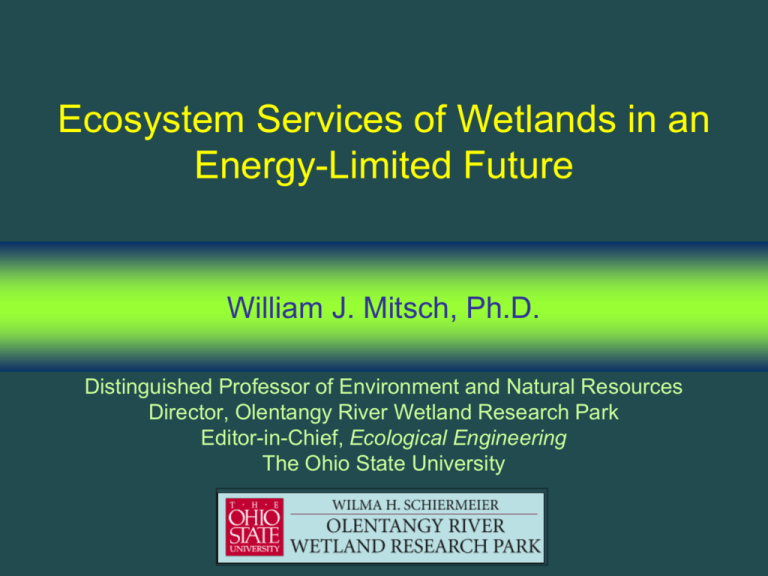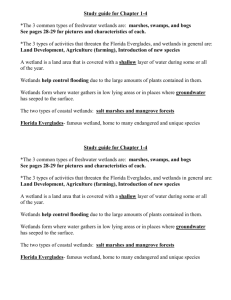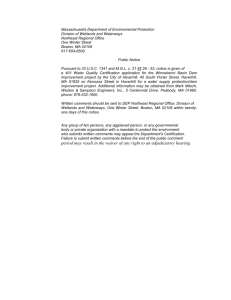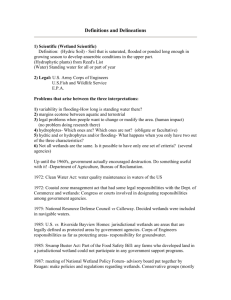Ecosystem Services of Wetlands in an Energy-Limited Future
advertisement

Ecosystem Services of Wetlands in an Energy-Limited Future William J. Mitsch, Ph.D. Distinguished Professor of Environment and Natural Resources Director, Olentangy River Wetland Research Park Editor-in-Chief, Ecological Engineering The Ohio State University Outline • The big global issues • Ecological engineering • Wetland ecosystem services and human history • Optimizing ecosystem services of wetlands—6 case studies • Conclusions Worldwide human population projection Human population (billions) 10 8 6 4 2 0 1800 1900 2000 2100 Source: Mitsch and Jørgensen 2004 Worldwide carbon and nitrogen 100 Percent Change 80 Available Nitrogen 60 40 20 Atmospheric CO 0 1900 1920 1940 2 1960 1980 2000 Source: Mitsch and Jørgensen 2004 Worldwide oil discovery and production Source: Day et al., 2009 Worldwide energy use projection Source: Clugston, 2007 710 Quads Quads/year 800 600 400 Optimistic 200 Conservative 1800 1900 2000 2100 2025-2030 Quad =1015 BTU or 1.055 × 1018 joules 2200 Ecosystems and Complexity Natural ecosystems are complex entropyfighting systems, and in that complexity comes an infinite amount of feedbacks and adaptations that contribute to resiliency. Human society, as a “part of” nature and not “apart from” nature would do well to recognize and use the important functions of nature (rather than destroy them) to provide a resilient and sustainable society. Conventional Engineering Mitsch (1998) Ecological Engineering ECOSYSTEM Mitsch (1998) Ecological Engineering the design of sustainable ecosystems that integrate human society with its natural environment for the benefit of both Source: Mitsch and Jørgensen, 2004. Ecological Engineering and Ecosystem Restoration, J. Wiley. The Spectrum of Ecological Engineering su stai nabi lity p oten tial lo w hi gh rel iance o n se lf-de sign lo w hi gh hu man engi neeri ng mo re Bio sphe re 2 Bio mani pula tion Soi l Bio remed iati on We tlan d Creation Sol ar Aq uati cs Wa stewater We tlan ds le ss Prai rie Res toration We tlan d Restorati on Mine land Resto ratio n Ag roecolog ica l Eng inee ring Wetlands and riparian ecosystems have major roles in restoring the viability of cities and rural areas Wetlands provide valuable ecosystem services: • Water quality improvement • Floodwater retention • Biodiversity islands and corridors • Carbon sequestration • Locations for human relaxation and nature observation/education Human History and Wetlands Babylonian Cultures in their Watery Environment Human History and Wetlands “Marsh Arabs,” southern Iraq Human History and Wetlands Camarguais, southern France Human History and Wetlands Cajuns, Louisiana (early 1900s) Human History and Wetlands Native Americans (Sokaogon Chippewa), Wisconsin Human History and Wetlands We have lost an estimated 50% of our original wetlands in the world. In Ohio, USA, we have lost 90% of our original wetlands. OPTIMIZING ECOSYSTEM SERVICES OF WETLANDS Restoring an ancient culture Mitsch and Gosselink. 2007 Wetlands, 4th ed., J. Wiley Restoring the Mesopotamian Marshlands Mitsch and Gosselink. 2007 Wetlands, 4th ed., J. Wiley Restoring the Mesopotamian Marshlands Mitsch and Gosselink. 2007 Wetlands, 4th ed., J. Wiley Restoring the Mesopotamian Marshlands Photo by Azzam Alwash, reprinted with permission in Mitsch and Gosselink. 2007 Wetlands, 4th ed., J. Wiley Protecting coastlines and coastal cities Indian Ocean Tsunami • 230,000 people killed or missing in late December 2004 as a result of a massive tsunami around the Indian Ocean caused by earthquake off the coast of Sumatra, Indonesia • Destruction of mangrove swamps for shrimp farms and tourist meccas bears some of the responsibility. • In the area hardest hit, 26% of mangrove wetlands, or 1.5 million ha, had been destroyed from 1980 to 2000 Indian Ocean Tsunami Mangrove Tidal Creek, Koh Phra Tong, Phang Nga, Thailand Before the Indian Ocean Tsunami Indian Ocean Tsunami Mangrove Tidal Creek, Koh Phra Tong, Phang Nga, Thailand After the Boxing Day Tsunami (February 2005) Indian Ocean Tsunami Coastal surges and mangrove forests Pre-tsunami—Simulation models illustrated that a wide (100 m) belt of dense mangrove trees (referred to as a “greenbelt”) could reduce a tsunami pressure flow by more than 90% (Hiraishi and Harada, 2003). Post tsunami—In an area of S.E. India there was significantly less damage where mangroves had been conserved (Danielsen et al., 2005; Science) Coastal Louisiana NEW ORLEANS 1870 1993 2020 1839 Past and Projected Wetland Loss in the Mississippi Delta (1839 to 2020) Coastal Louisiana 1: August 23, 2005 2: August 26, 2005 3: August 28, 2005 4: August 29, 2005 Hurricane Katrina, Aug 23-29, 2005 TROPICAL DEPRESSION TROPICAL STORM CATEGORY 1 CATEGORY 2 CATEGORY 3 CATEGORY 4 CATEGORY 5 Coastal Louisiana Hurricane Katrina storm surge near New Orleans, estimated to be 5.5 - 6 m high Coastal Louisiana Coastal Louisiana March 5, 2001 pre-diversion March 21, 2001 during diversion River diversions may be one of the answers to wetland loss in Louisiana Coastal Louisiana Gulf of Mexico BP oil spill of 20 April 2010 Restoring water quality in watersheds to prevent downstream impacts Mississippi-Ohio-Missouri (MOM) Basin Restoration Gulf of Mexico Hypoxia Mississippi-Ohio-Missouri River Basin Major nitrate sources in MOM General extent of hypoxia in Gulf of Mexico Mississippi River Basin boundary Mississippi-Ohio-Missouri (MOM) Basin Restoration The Gulf of Mexico Hypoxia in 2008 = 20,700 km2 (8,000 mi2) Mississippi-Ohio-Missouri (MOM) Basin Restoration Mitsch et al. 2001 Better Fertilizer Management Created/Restored Wetlands Restored Riparian Bottomlands 2 million hectares of these ecosystems are needed Wilma H. Schiermeier Olentangy River Wetland Research Park Mississippi-Ohio-Missouri (MOM) Basin Restoration Goal is to create 28,000 ha of riparian systems and wetlands in one watershed in Ohio Columbus OHIO Restoring the Florida Everglades Restoring the Florida Everglades Restoring the Florida Everglades Florida has installed thousands of hectares of wetlands to reduce the phosphorus inflow to the Everglades Sequestering carbon Carbon Sequestration in Wetlands g-C m-2 yr-1 Wetland type General range for wetlands Tropical wetland (9.5 m core from Indonesia) Reference 20–140 Mitra et al. (2005) 56 (for 24,000 yrs) Page et al. (2004) 94 (for last 500 yrs) Boreal peatlands 15–26 Turunen et al. (2002) Temperate peatlands 10–46 Turunen et al. (2002) Created temperate marshes, OH (10year average) 180–190 Anderson and Mitsch (2006) Restored prairie pothole wetlands, North America 305 Euliss et al. (2006) Reference prairie pothole wetlands 83 Euliss et al. (2006) EARTH University tropical wetland 255 Bernal and Mitsch Old Woman Creek Ohio, temperate wetland 143 Bernal and Mitsch Source: Mitsch and Gosselink, 2007 Pools: Pg (=1015 g) Fluxes: Pg/yr Conclusions • If ever there were a transdiscipline whose time has come, it is ecological engineering. Conclusions Global energy use/year Ecological Engineering needed Ecological Engineering developed 1800 1900 2000 2100 2025-2030 2200 Conclusions • Wetlands provide many ecosystem services such as human protection in coastal areas, water quality improvement in watersheds, and carbon retention almost everywhere. Their conservation, creation, and restoration should be international priorities. Conclusions • City landscapes especially should include wetland ecosystems for the many ecosystem services that they provide including human relaxation and ecological education. Conclusions • Wetland parks as part of urban developments, can not only be maintained with a small carbon cost but also as large carbon sinks. Conclusions • Engineers, scientists, and policy makers need to recognize that Mother Nature (self-design) and Father Time (it takes time) are the parents and guardians of functional ecosystems. Acknowledgements O H I O Thank you very much! http://swamp.osu.edu mitsch.1@osu.edu






